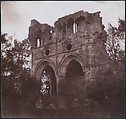The Tomb of Sir Walter Scott, in Dryburgh Abbey
William Henry Fox Talbot British
Not on view
Talbot's second photographically illustrated book, entitled Sun Pictures in Scotland and published in 1845 with no text other than a list of plates, transported the reader via photography to sites significant to the life and writings of Sir Walter Scott. Among the images included was The Tomb of Sir Walter Scott, in Dryburgh Abbey, a romantic expression perfectly suited to the writer. The tomb is embedded in the shadows of the Gothic ruin, itself nestled among the trees that grow where columns of the transept once rose, the whole scene in turn subsumed in the deep, rich tones of the calotype. Copies of this image in Sun Pictures, like many plates in The Pencil of Nature, faded dramatically from their original dark chocolate brown even in Talbot's time, due to impurities in the printing establishment's water supply, to the printer having inadequately washed out the hypo fixer, and to the publishers having trimmed and affixed them to bristol, which left them more vulnerable to oxidation and exposed them to chemicals in the mounting glue. The example shown here-never trimmed, mounted, or distributed-is extraordinary in its rich tonalities and exquisite state of preservation.
Due to rights restrictions, this image cannot be enlarged, viewed at full screen, or downloaded.

